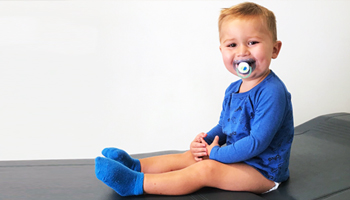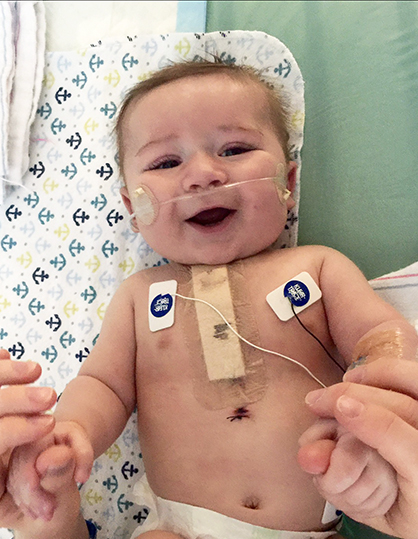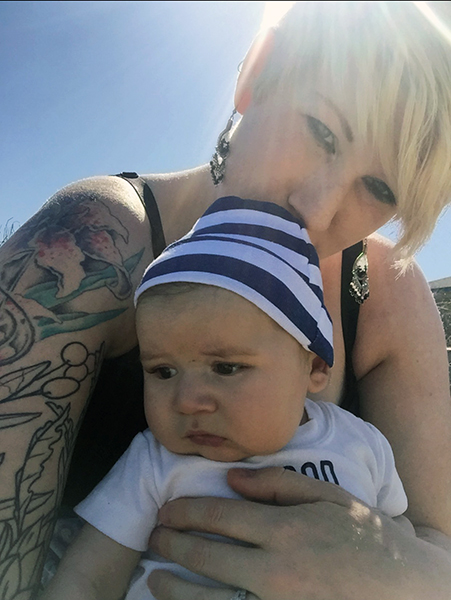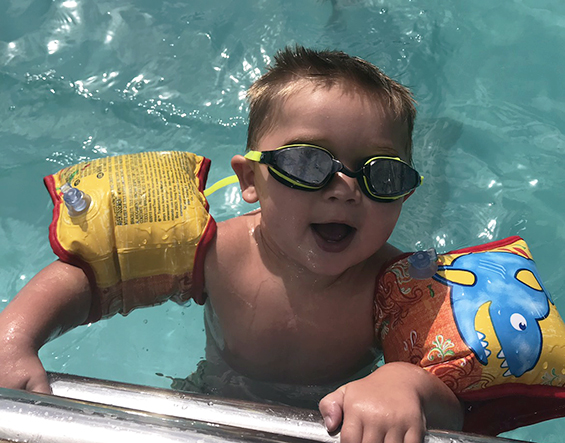HOW CAN WE HELP YOU? Call 1-800-TRY-CHOP
In This Section
Research Heroes: Heart to Heart - How the Readman Family Supports Cardiac Research
 Two-year-old Jax Readman might not remember the two open heart surgeries he had at Children’s Hospital of Philadelphia for a complex cardiac defect, but his mom, Haley, looks forward to the day that she can share with Jax all of the positive, powerful, and pretty cool things the family has done to support heart research since his birth.
Two-year-old Jax Readman might not remember the two open heart surgeries he had at Children’s Hospital of Philadelphia for a complex cardiac defect, but his mom, Haley, looks forward to the day that she can share with Jax all of the positive, powerful, and pretty cool things the family has done to support heart research since his birth.
From the benefits they’ve hosted to support the CHOP Cardiac Center, to the galas attended to share their story for the March of Dimes, Jax will have no shortage of happy memories about how he and his family help to raise money and spread awareness for research into single ventricle heart defects.
 Jax was born with hypoplastic left heart syndrome, a type of single ventricle anomaly in which the left side of the heart is underdeveloped and unable to do its job of pumping out oxygenated blood. In order to repair this, Jax underwent the first of three “staged reconstruction” surgeries at CHOP just six days after his birth. Four months later, the family returned so that Jax could have his second surgery, the Glenn Procedure.
Jax was born with hypoplastic left heart syndrome, a type of single ventricle anomaly in which the left side of the heart is underdeveloped and unable to do its job of pumping out oxygenated blood. In order to repair this, Jax underwent the first of three “staged reconstruction” surgeries at CHOP just six days after his birth. Four months later, the family returned so that Jax could have his second surgery, the Glenn Procedure.
But while the vulnerable days in between the two operations were spent recuperating at their home in Kitty Hawk, N.C. — about 350 miles south from Philadelphia — Haley, her husband, Craig, and Jax and were also using the time to help improve outcomes for families like theirs in a different way.
After Jax’s birth, Haley signed up to participate in the Transitional Telehealth Home Care (REACH) intervention — a study led by Barbara Medoff-Cooper, PhD, RN, FAAN, professor of Pediatric Nursing at CHOP and the University of Pennsylvania School of Nursing. Funded by the National Institute for Nursing Research, the five-year long REACH study began in 2011 and concluded last summer. The goal was to investigate whether additional contact with families who were discharged after cardiac surgery could improve outcomes for parents and babies compared to usual care.
“The purpose of the REACH study was to support family transition from the hospital to home,” Dr. Medoff-Cooper said.
The trial addressed many critical concerns nurses had for infants with complex congenital cardiac defects who require increased monitoring between and after surgeries to prevent life-threatening events and improve growth. Congenital heart defects can affect parents, too: An important outcome from the REACH study was that mothers of infants born with heart defects often experience a lot of stress and anxiety.
Life Between Heart Surgeries
REACH provided an additional intervention atop CHOP’s standard-of-care Infant Single Ventricle Monitoring Program. Dr. Medoff-Cooper and her team wanted to know whether the unique addition of telehealth communication after discharge — including twice-weekly videoconferencing — could positively impact a variety of outcomes, from ensuring that baby feeds regularly and reaches a healthy weight, to observing a mother’s stress or anxiety levels as she cares for her new infant.
“The trial focused on decreasing parental stress, increasing their quality of life, and decreasing healthcare utilization,” explained Desiree Fleck, PhD, CRNP, nurse practitioner at the University of Pennsylvania School of Nursing and project manager of the REACH Trial.
Reaching Families at Home
As part of the study, Haley, Craig, and Jax began the routine assigned to them when they returned home following Jax’s first surgery. For over four months every day, they logged Jax’s oxygen levels and feeding intake over a 24-hour period, along with the medicine he was taking, and weight gain or loss as compared to the previous day. On top of that, they messaged the REACH team daily about Jax’s stats and other issues, such as whether he was vomiting or had diarrhea.
Twice a week, the family also had video calls with Dr. Fleck and other nurse practitioners so that they could physically see Jax’s color (babies with single ventricle heart defects can take on a bluish, dusky tint) and his growth (adequate growth can indicate stable heart function).
“Because we viewed the data daily, we were able to pick up things and avoid mortality or morbidity,” Dr. Fleck said. “Anecdotally, moms loved having a second set of eyes on their baby; it was reassuring to them.” She added that close communication with CHOP’s Single Ventricle Monitoring Program is “essential” to ensuring the infants’ safety.
second set of eyes on their baby; it was reassuring to them.” She added that close communication with CHOP’s Single Ventricle Monitoring Program is “essential” to ensuring the infants’ safety.
As for Haley, joining REACH also provided her with the comfort of connection.
“It felt like I was doing research along with [the CHOP nurses], and I’m also seeing how much my child is progressing over this amount of time,” she said. “That gave me reassurance knowing that I would be far away in a smaller town that didn’t have all of the medical necessities that we would need for Jax. And then from there, it was kind of cool because it just opened doors for us to build relationships with the people we talked closely with daily, and I still keep in touch with them right now.”
In fact, Dr. Fleck drove down to North Carolina to attend one of the Readman benefits in support of CHOP and felt touched by the opportunity to get involved in participants lives.
“It was remarkable to have the families welcome us into their home, to share their pain and happiness,” Dr. Fleck said. “We got to know the families and the babies intimately, which was a true privilege. We were excited to watch the infants smile for the first time, learn to turn, and do those things infants are supposed to do. Without research, we can’t learn how to make lives better.”
Giving Back with Heart
 As a “crazy and wild” 2-year-old, nothing is slowing down Jax Readman. He loves bike rides, beach days, travelling with his family, and sometimes pulls his 6-year-old sister Ruby’s hair. And the Readman’s remain active in raising money and awareness to support heart research as well as healthy living. Haley is eager to plan outdoor activities, formal benefits, and fundraisers that promote heart-healthy lifestyles whenever possible, like 5K races around the beach.
As a “crazy and wild” 2-year-old, nothing is slowing down Jax Readman. He loves bike rides, beach days, travelling with his family, and sometimes pulls his 6-year-old sister Ruby’s hair. And the Readman’s remain active in raising money and awareness to support heart research as well as healthy living. Haley is eager to plan outdoor activities, formal benefits, and fundraisers that promote heart-healthy lifestyles whenever possible, like 5K races around the beach.
“We want to give back,” Haley said. “I see my husband and I as giving benefits or some kind of thing that we can do to support CHOP because we can’t really repay for what they’ve done so far.”